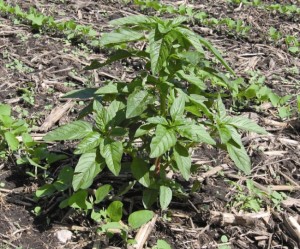Multiple Herbicide Resistance Found In Illinois Waterhemp

Common/Tall Waterhemp
Herbicide-resistant waterhemp populations will challenge weed management practices and practitioners during the 2012 growing season.
University of Illinois associate professor of weed science Aaron Hager said that the increasing occurrence of waterhemp populations that possess resistance to herbicides spanning more than one site of action further complicates management because the efficacy of multiple herbicides is compromised.
Last year, University of Illinois weed science specialists published the results of a herbicide-resistance screening program for waterhemp samples submitted during the 2010 growing season. The program uses molecular biology techniques to detect herbicide-resistance traits (glyphosate, PPO inhibitors, and ALS inhibitors) in waterhemp. In 2011, a total of 408 plants from 97 different fields suspected of having glyphosate-resistant waterhemp were submitted.
Hager explained that distinguishing between multiple herbicide resistance at the field and individual plant levels is important and can impact management options.
“Field-level multiple resistance is when resistance to herbicides from more than one site of action is present within the population growing in any particular field,” he said. “When multiple-herbicide resistance occurs at the plant level, individual plants demonstrate resistance to herbicides encompassing more than one site of action.”
Thus, when three types of resistance are present at the field level and individual plants are resistant to only one herbicide, a three-way tank mixture of herbicides A, B, and C could control all the plants in the field. However, tank mixtures of herbicides A, B, and C would not control individual plants that possess resistance to these three herbicides.
Multiple resistance often occurs at both levels in a single population. A field often includes a mix of plants, some of which are resistant to just one herbicide (or herbicide family) while others are resistant to multiple herbicide families. Tankmixing two or more postemergence herbicides may not effectively control herbicide-resistant waterhemp under these conditions.
Of the 408 plants submitted and screened from 2011, only 13% were sensitive to all three herbicides; the rest of the plants in the sample were resistant to at least one herbicide. Twenty-eight percent, 19%, and 3% of the plants were resistant only to glyphosate, ALS inhibitors, or PPO inhibitors, respectively.
On a field basis, only 4% of the 97 fields from which plants were sampled had no herbicide-resistant waterhemp. Approximately 25% of the fields contained waterhemp resistant to PPO inhibitors, 84% of the fields contained waterhemp resistant to ALS inhibitors, and 66% of the fields contained glyphosate-resistant waterhemp.
“Keep in mind that these fields – and plants within fields – were not randomly selected but were sampled based on suspected resistance to glyphosate,” said Hager. He also noted that the field-level results are based on small samples (five or fewer plants per field). “It is likely that, had a larger number of samples been taken, we would have found more fields with resistance to ALS and PPO inhibitors,” he said.
Even with this sample-size limitation, over 10% of the fields were found to contain three different types of herbicide resistance, which greatly increases the difficulty of managing these populations using only postemergence herbicides labeled for use in conventional or glyphosate-resistant soybean varieties. Results from this and previous surveys suggest that glyphosate-resistant waterhemp occurs in many fields across the southern two-thirds of Illinois.
This survey was only one project in the ongoing research portfolio on herbicide-resistant weeds in Illinois. Weed scientists at several Illinois universities are studying this phenomenon and working to develop viable solutions for Illinois growers. Much of this research is made possible by multiple public and private funding sources, including the Illinois Soybean Association.





